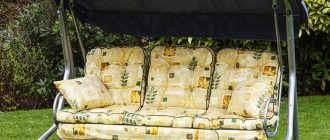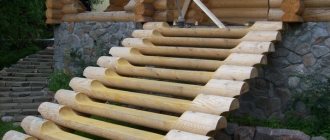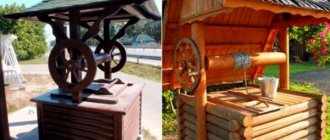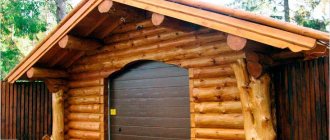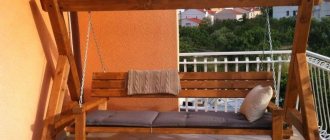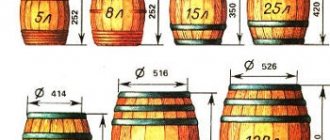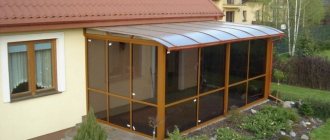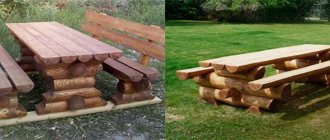A beautiful garden on a summer cottage creates a special atmosphere. Therefore, many people install gazebos and swings on the territory. Monotonous rocking calms the nervous system and trains the vestibular apparatus. Many people make swings from logs with their own hands. And after a fruitful day, they relax under the crowns of fruit trees.
Log swings can be one-, two-, three-seater, for children and for families
Pros and cons of homemade log swings
Wood is considered a popular building material. To decide whether such a swing should be made, it is worth considering its positive and negative sides.
Pros:
- Logs for construction are more often available than lumber. Treated lumber is more expensive, and it is not always possible to buy it nearby. If the dacha is located near a forest or planting, logs are obtained for free by cutting down a couple of dry trees.
- Wood is a natural, environmentally friendly material. The self-assembled structure is completely safe for children.
- If the wood is well treated, varnished, and stained, the swing will turn out much more beautiful than a metal structure.
- Wooden swings still have many advantages, but you also need to know about the disadvantages:
- Wood, compared to metal, requires frequent maintenance throughout the life of the product.
- To make a structure with your own hands, you will need long, even logs 10-15 cm thick. Finding material with such parameters is sometimes problematic.
- Wood weakly resists the influence of harmful environmental factors. Under the sun, rain, snow, the material disappears. Logs may crack. Moisture gets into the cracks and they begin to rot. Damage to wood is caused by temperature changes and grinder beetles.
Despite the existing shortcomings, a DIY log garden swing will last from 5 to 10 years. During this time, the children will have time to grow up, and the structure may no longer be needed.
Types of garden swings made of logs
Play structures differ in design, installation method, size and other parameters. They assemble the structures with their own hands according to common designs and come up with their own exclusive options.
In general terms, all swings differ in the installation method:
- Suspended models are considered the most profitable design in terms of installation method and do-it-yourself manufacturing. The product is a seat suspended on ropes or chains to a support. In order not to look for long, even logs, a growing tree is used as a support. The ropes are secured to a high thick branch. For the seat you will need short pieces of logs that are easy to find in the planting.
Important! Hanging swings come with a wide seat and a narrow one made from one piece of log. The second option is a bungee. You can ride it sitting or standing. - Portable models do not dig stands into the ground. They are placed on the ground surface and, if necessary, moved to another place. The supports are made stable. When viewed from the side, they may resemble the letter "L", "A", "P" or an inverted "T".
- In the photo, a stationary log swing looks exactly the same as a portable structure. The only difference is the installation method. The supports are buried in the ground or filled with concrete. It is impossible to move the swing to another place without dismantling it. If the posts are filled with concrete, they will only have to be cut down.
The next difference between swings is their purpose:
- Family type models are large in size. The seat is a bench, usually accommodating 3-5 people at a time. The structure requires strong supports and reliable fastenings. When making your own, it is better to use trunks from hardwood trees.
- Children's swings are more of the hanging type. The seat is secured to the support with ropes or chains. It accommodates one, and sometimes two people. The seat can be a piece of ordinary board or a chair with a back and armrest.
Important! Children's swings are not designed for heavy loads.
- Models for adults are similar to family swings. They are installed not only by summer residents, but also by cottage owners. Products are designed for heavy loads. Often the design is made with an equipped seating area. A distinctive feature is the presence of a canopy or enclosing frame covered with mosquito netting.
Before you start assembling a swing from a rounded log, you must immediately decide on the model.
Types of designs
The first step to creation is choosing a location and type of structure. There are more than 20 varieties of garden swings made of wood. Their differences lie in design features, dimensions, purpose, and type of seat. In terms of mobility and weight, the most common types are:
- Stationary. They are characterized by large sizes, a firmly fixed base: it is either poured with concrete or buried in the ground. A swing made of this type of wood can be installed in a gazebo. In this case, the base is mounted on the floor.
- Portable. They are lightweight and compact in design. It is stable and does not require fastening. The swing is easy to carry due to its low weight.
- Collapsible. Such products consist of a frame and a suspended structure. A special type of threaded fasteners facilitates repeated assembly and disassembly of the swing. The compact size when folded allows you to transport them in a car and take them with you to nature.
- Hanging. Swing models of this type often do not have a frame. The simplest option is rope with a wooden plank as a seat, which can be hung on a tree, to a beam on the veranda or a horizontal bar in the house. Complex types are attached using hooks on the ceiling. An example is hanging nest chairs made of factory-made rattan or do-it-yourself wooden swing benches.
There are adult and children's options based on the weight they can bear. The latter are usually used for entertainment. Children's swings made of wood are almost always single-seater, while for the older generations of the family, romantic double-seater models with opposite seats, as well as multi-seater ones in the form of sofas, are installed.
Portable
Hanging
Collapsible
Stationary
Among the types of swings installed at the dacha with your own hands, designs with sun protection are very popular. This can be a canopy made of straw, an awning on a frame made of slats, or a canopy made of plastic. It is better to place products without such devices in a shady place. There are several types of swings based on the structure of the frame:
- U-shaped. Consist of two vertical posts and one horizontal crossbar. Stability depends on the reliability of fastening in the ground (or other foundation). Creating such a wooden swing with your own hands will require a little time and materials.
- L-shaped. It is a structure of two pairs of bars and a crossbar connected at the top point. The model is stable and does not require careful strengthening.
- X-shaped. This design has low support connections, resulting in the formation of lintels on which timber is laid horizontally. The swing is simple to make, but requires additional reinforcement at the base.
- A-shaped. They are characterized by increased stability due to additional structural elements - sidewalls, which increase reliability. They are best adapted to a full-fledged complex for children with ropes and ladders.
Before you make a swing, you need to prepare the materials. It is necessary to decide in advance which types of wood are best to use and how to treat the surface. The reliability, durability, and safety of the product depend on the choice of source material.
A-shaped
L-shaped
U-shaped
X-shaped
What is needed to make a swing from logs in the country
If the choice fell on this type of swing, then first of all you will need logs to make them. When purchasing or preparing material with your own hands, preference is given to trees of three species:
- Pine is considered the most common material. The logs are usually smooth with a small number of knots. Wood is easy to process, but quickly disappears from dampness. Of the coniferous species, it is better to choose larch. Due to its saturation with resins, the wood is resistant to moisture and will last a long time.
- Oak is a representative of hardwood trees. The swing will last for many years and will not rot in dampness. The downside is the high cost of the material and the complexity of processing. To cut a log for a swing, you will need a powerful tool. This is difficult to do with a hand saw. A perfectly straight and long oak log is rarely found. In addition, wood is heavy.
- The quality of linden is not inferior to oak. If you can get such logs, they will make a strong swing. When well processed, linden looks beautiful.
In addition to logs, you may need a piece of board for the swing to make a seat with your own hands. Additionally, you need a rope or chain, anchors with loops for hanging from the support. Woodworking tools will require a chainsaw or electric saw, an axe, a grinder, a tape measure, and a level.
Drawings of a swing made of logs with your own hands
To have an idea of the future design and to correctly calculate the material, you need a diagram. You can find a ready-made one on the Internet or draw it yourself by copying a swing model found on the site.
For a do-it-yourself log swing, be sure to indicate on the diagram the dimensions of all structural components. The racks must rise above ground level at least 2 m. For a stationary type structure, one support can be placed on the sides. For it, take a log at least 20 cm thick, bury it well in the ground and concrete it. The most stable supports are those in the shape of the letter “L” or “A”. To create them, one swing will require four stands.
For a seat in the shape of a chair or bench, the optimal depth is 40 cm. The height of the backrest is made from 40 to 60 cm. The length of the chains from the back of the chair to the crossbar is 90 cm, and from the front of the seat – 120 cm.
Preparation of the drawing
Before starting work, it is important to make a drawing of the future building. To facilitate work at this stage, it is recommended to use any ready-made drawing suitable for the type of swing. If desired, the product parameters can be proportionally changed in any direction.
In the process of preparing the drawing and creating individual elements of the swing, the following factors should be taken into account:
- The shape of the frame has a direct impact on the stability of the structure. Therefore, it is recommended to create A-shaped or L-shaped frames. Using only one log on each side as a support is possible in the case when the diameter of the trunks exceeds 20 cm, and there will be a swing for one child on it. In this case, the trunks must be dug into the ground at least 40 cm. However, for greater reliability, the racks are additionally fixed with oblique supports;
- The height of the seat back is 40-60 cm;
- The depth of the seat is 40-50 cm. When creating a swing on which you can lie down, the depth of the seat can be significantly increased;
- The length of the cable or chains is calculated individually. In this case, a comfortable distance from the seat to the mounting beam is 90-120 cm.
When creating a wooden structure project, you should definitely take into account the physiological characteristics of family members. However, you should not make a large reserve in the size of the seats or supports.
How to make a swing from logs with your own hands
The entire process of making a swing is divided into three stages:
- scheme development;
- preparing tools and materials for work;
- manufacturing and installation of the structure.
At the time of the start of work, the master must 100% decide what kind of structure he will create.
An example of making a swing is shown in the video:
Simple garden swing made of logs
Hanging swings are often installed in the garden with your own hands. If you decide to make supports, then for this design you can use two logs for the side posts, one goes to the lintel. From small pieces in the lower part, stops are created in the form of jibs so that the posts are not concreted into the ground. The seat is similarly cut from a piece of log. For older children it is done without a backrest. Using eye bolts and chains, the seat is suspended from the crossbar.
The simplest version of a hanging garden swing is a bungee swing. The rope is attached to a high tree branch. Sometimes a pole is buried in the ground. A crossbar is attached to the top, to which two ropes are tied to form a double bungee. The seat is made from a piece of thin round timber. A hole is drilled in the center, a rope is passed through, and a knot is tied at the bottom for support. People can ride the bungee while sitting or standing.
For a small child, the seat is made in the shape of a chair. A piece of log 50 cm thick is placed vertically. Use a chainsaw to cut out a recess at the end to create a backrest and armrests. To hang it from a support, four eye bolts are driven into the chair, chains and carabiners are used.
DIY swing-balancer made of logs
For pair skating, there is a special type of swing called a balancer. The essence of the design is a long lever, the center of which rests on a support, it can be a board or a log.
Any person can install such a children's swing from logs with his own hands in a couple of hours. For support, you will need two logs 1.2 m long, 10-40 cm thick. They are dug vertically into the ground to a depth of 60 cm. A gap of 40 cm is left between the logs. Through coaxial holes are drilled at the top. Insert a metal threaded pin.
A similar hole is drilled in the center of the lever. For it, take a log 2.5 m long, 10 cm thick. The lever is placed between the posts, and a pin is passed through all the holes. Screw two nuts onto the threads on both sides and tighten securely with wrenches. Handles are placed at the ends of the lever, and the seats are arranged in the form of a recess.
Advice! If there is no long log, use a board at least 4 cm thick for leverage.
Log swing with roof
A swing made of boards and logs of a family or adult type, where an additional structure is provided with a canopy, is considered a complex structure. The step-by-step process consists of the following steps:
- Prepare a drawing of the frame. It is important to remember that in addition to the large weight of the structure, an additional structure is the roof. Even a small canopy has sailing capacity. To ensure the stability of such a swing, you will need a strong frame on four posts. A hole is dug under each support in a marked place. The depth of the pits is 1 m. Sand is poured into the bottom in a layer of 5 cm and crushed stone - 10 cm. The pillow is filled with water, and after absorption it is compacted.
- To prevent the supports from rotting in the ground, the ends of the logs are coated with a thick layer of bitumen. You can additionally wrap the top with two layers of roofing material. Each pair of logs forming a side stand is lowered into a hole and placed on a slope. The tops of the supports are connected with long pins through through holes to form the letter “L”.
- They hammer in liquid concrete with the addition of small crushed stone with their own hands. Having aligned the support vertically, each hole with a log is filled with mortar. Give it time to harden.
- To ensure maximum strength to the frame, the two posts of each side support are connected by a horizontal jumper. Now their shape resembles the letter “A”. The tops of the supports are connected with a long log. The swing seat and the canopy itself will be attached to the crossbar with your own hands.
- It is more convenient to make the roof from boards. If this is not available, thin round timber 5 cm thick will do. First, create a rectangular frame. It is attached to the crossbar and the tops of the supports with self-tapping screws. They put up supports and jibs. In the absence of boards, the frame of the canopy is covered with tarpaulin, using natural materials: reeds, bamboo, thin tree branches.
To create a bench, take 4 thin logs 70 cm long. They are connected with boards of the same length to make 2 shields. One element will act as a backrest, and the other will serve as a seat. The boards are connected at an angle of 110 degrees. Armrests are made from pieces of thin round timber. The bench is suspended from the crossbar with chains or ropes.
The final part is coloring. The wood is impregnated with an antiseptic. Drying oil, stain, paint or varnish are suitable for applying to the surface of the swing.
Useful tips
To ensure that your assembled wooden swings from logs serve you for a long time, you should use useful tips for caring for them:
- The canopy will protect the wooden structure from rain and snow. It is advisable to provide it for any swing, except for the simplest hanging model.
- Every autumn, the wood is treated with an antiseptic solution or a stain that contains wax.
- If the swing is collapsible, storing it in a barn in winter will help extend its service life.
- Twice a season the tree is opened with varnish. If necessary, clean off the old layer with fine-grained sandpaper.
To make wooden swings last longer, they are installed further from ponds and other sources of water.
Tools and materials
The main material for making swings of any kind is wood. At the same time, almost any type of tree can be used to create a swing. However, logs from coniferous trees, with the exception of spruce, are most suitable for these purposes. It does not have the necessary strength. The best material is larch, which only becomes stronger over time and under the influence of moderate amounts of moisture. An alternative to it can be pine.
To create a wooden swing with a frame you will need the following materials and tools:
- Logs;
- Fine-grained sandpaper;
- Drill with a set of drills;
- Chainsaw;
- Hacksaw or jigsaw;
- Metal ring screws, eye bolts;
- Carbines;
- Hammer;
- Plane;
- Roulette;
- Square;
- Pencil;
- Level;
- Welded chain or fabric rope with a metal core;
- Self-tapping screws;
- Screwdriver or screwdriver;
- Boards.
To create a swing from logs, you will need a chainsaw.
When making a balance beam, instead of carabiners and screws with a ring, you will need a metal rod.
The amount of materials directly depends on the size of the structure. However, any wooden building will additionally require an antiseptic and possibly varnish.
